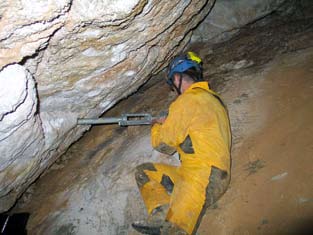Surface Versus Underground Measurements of Active Tectonic Displacements with TM 71 Exstensometers in Slovenia
DOI:
https://doi.org/10.3986/ac.v38i2-3.123Povzetek
The tectonic setting of W Slovenia is characterised by NW-SE trending dextral strike-slip fault systems and moderate seismicity. Monitoring of tectonic movements along five presumably active faults or in their vicinity using TM 71 extensometers was set up in 2004. In five years of monitoring some clear trends of displacement were established. The morphologically most prominent fault in W Slovenia is Idrija Fault having a total length of more than 120 km. The average lateral displacement measured along a crack in its inner fault zone in Učja valley was 0.26 mm/year. Short-term rates were even greater and reached 0.54 mm/year. Raša Fault monitoring site at the foot of Vremščica Mt. established first an average uplift of SW block for 0.16 mm/year and left-lateral displacement of 0.16 mm/ year. It was followed by down-slip of the same block at the rate of 0.37 mm/year. In Postojnska Jama two instruments, 260 m apart, were installed at the fault zone, which extends about 1 km northeast from Predjama Fault. We detect small tectonic deformations, dextral horizontal movement of 0.05 mm in 5 years for Postojna 1 and extension of 0.03 mm in 5 years for Postojna 2. Both devices recorded similar reactions to some earthquakes with magnitude range 3.1-5.2 and epicentral distance of 12-95 km. The amplitude of individual peaks is in the order of 0.08 mm. The monitoring at Kneža Fault started at the end of 2006. In two years clear oblique displacement was established with left-lateral rate of 0.06 mm/year and uplift of SW block for 0.06 mm/year. Monitoring in Pološka Jama situated in vicinity of the Ravne Fault started in 2008. Preliminary results show 0.08 mm of horizontal displacement between two limestone beds. Established displacements proved the active tectonic movement of all monitored faults. Observed deformation rates can be compared with the regional deformation rate in W Slovenia established from GPS measurement, which is in the order of 2 mm/year.Prenosi

Prenosi
Objavljeno
2009-12-01
Kako citirati
Gosar, A., Šebela, S., Koštak, B., & Stemberk, J. (2009). Surface Versus Underground Measurements of Active Tectonic Displacements with TM 71 Exstensometers in Slovenia. Acta Carsologica, 38(2-3). https://doi.org/10.3986/ac.v38i2-3.123
Številka
Rubrike
Original papers
Licenca
Avtorji jamčijo, da je delo njihova avtorska stvaritev, da v njem niso kršene avtorske pravice tretjih oseb ali kake druge pravice. V primeru zahtevkov tretjih oseb se avtorji zavezujejo, da bodo varovali interese založnika ter da bodo povrnili morebitno škodo.
Podrobneje v rubriki: Prispevki




